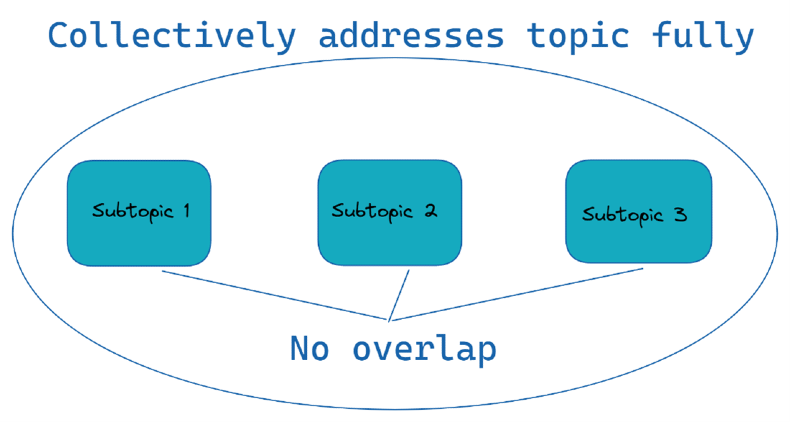Let's face it: A lot of B2B content doesn't miss the mark as much as land in a different time zone.
Copycat content, endless skyscraper strategies, and SEO mania are all reducing the quality of B2B content marketing. It's no wonder a lot of the content is labeled "boring."
Some practitioners think that better and more creative writing is the solution. However, that approach fundamentally misunderstands content writing's purpose. Content has to have utility—an objective—unlike creative writing, which does not need a reason to exist (like all forms of art).
Instead of trying to "write better" or commission snappier writing, focus on the following areas when evaluating your content. Your audience will reward you for it.
Is your content well-organized?
Here's a mistake that many new content writers and companies make when adopting content marketing for the first time: They focus on their language instead of their content's structure.
Your prospects (content consumers) want to get something out of your content, which is why plain language and exemplary structure deliver better results. Get to the point and give information in the most helpful way possible.
So how should you organize your content for maximum impact?
1. Begin with your reader's intent
Which audience question/issue/problem are you solving with this piece? What is your value proposition? If you can distill that into a couple of sentences, you're on the right track.
For instance, you want to write a blog about annual recurring revenue (ARR). Your audience is a CXO/founder persona. Your value prop might be "We want to deliver business-oriented conclusions and insights regarding ARR and its implications on company valuation."
Compare that with this SEO-oriented value offering: "We want to rank as high as possible so more people will find us. We'll cover everything there is to know about ARR, including someone's thoughts about it back in 2010, including a lengthy definition of it in an H2 heading."
The former value prop gives you a high-level picture of what to talk about and how to organize your content. The latter points to a mishmash of subtopics that might rank well but they are organized poorly for a human reader.
2. Select subtopics to address
Once your value prop is in place, you'll have a simpler time selecting which subtopics to address.
For instance, our CXO persona doesn't need a lengthy definition of what ARR is. The persona will, however, need benchmarks, industry insights, and the venture capitalist's view of ARR as a valuation tool.
3. MECE it
Once you have a list of subtopics, it's time to organize the flow using the Mutually-Exclusive-Collectively-Exhaustive (MECE) framework.
Here's a simple illustration of how MECE works.

A few things to note about MECE as it relates to content creation:
- Deliver insight first, explanation and data after.
- Write directly. Minimize fluff.
- Connect each subtopic back to your value prop.
- Take as much time as you need to address the subject from all angles.
Following that process helps you establish a flow, boosting the value your prospect receives. The greater the value, the "better" your content.
Is your content distribution-worthy?
You don't have a distribution problem; you have a content-quality headache. Good content is highly distributable. Or, in plain English, it's something you wouldn't be embarrassed to send to a prospect and say, "Hey, here's something you'll find useful."
Let's say I want to help my prospects figure out more ways to make money. Here's what Google returns:

From top to bottom: 25, 10, 7, 40, 32, and 25 ways to make money. The skyscraper approach would have us writing 57 ways to make money online. But why would anyone want to read that? We're not adding anything to the conversation. Clearly, the idea isn't distribution-worthy.
What if we wrote about screwing up the most popular ways of making money? We'd list the popular ways separately and then say, "Here are the things you can do to make sure they don't work for you."
Our content angle flips the question and gives prospects everything that hinders success. There's far greater value in that than in producing another generic listicle. The unique angle also gives us a great way to introduce and distribute our content.
"What about SEO?" you might ask. Who cares? If your prospects find your piece useful, Google will eventually figure out you're bringing something unique to the table and it will reward you.
Begin by asking what piece of content you'd be proud to distribute, and go from there. That approach will solve your quality issues.
Does your content use storytelling selectively?
Storytelling in B2B content is overrated. (Guess who just got booted from the upcoming content marketer cocktail party?)
We've all heard the reasons to include storytelling: "People connect with stories," "Stories emotionally engage our audience," and so on.
I'm not saying storytelling has no place in B2B content. We do need to use it—selectively, however. The storytelling-as-a-technique trope is highly overused.
Here are two things to remember about storytelling.
1. Utility engages more than stories
You can tell a great story, but if your content has no utility, the story isn't going to land. A "how to" or informational piece doesn't need a stirring story. In those types of content, a story will distract your prospect.
Here is an example of an article that delivers value and moves on. Note the topic and the persona it targets.
2. Deploy stories when you need to convince your prospect
You need stories if you're proposing something new in your industry or creating sales-oriented content. For instance, stories work well in case studies, especially when describing the pain points and the results.
Here is a great example of a storytelling approach working well in a highly technical field addressing a sophisticated audience.
Does your content have great UX?
In 2021, Google formally rolled out a feature many SEO experts had long suspected was in the works. The Page Experience update gave a prominent search algorithm feature an official name, confirming that on-page UX is important for SERP rankings.
We're not discussing SEO here, but Google's update reflects how it views users' consumption of content. Content that is well-designed on a page performs better. Features such as font size, page width, text spacing, images, and a clickable table of contents all matter.
Here are a few more points on UX.
1. UX will not solve poor performance
Great UX will not overcome content that has poor utility. However, it does raise the bar your content has to reach for a prospect to deem it useful.
For example, if you're viewing two pages with similar content, you're more likely to pay attention to the one with better UX.
2. UX is critical for technical content
UX also matters when you're delivering intricate and technical content.
Here is a good example of great UX that simplifies content consumption. The dynamic TOC gives the reader the overall context at all times. The content width helps the reader focus on a smaller area, making content easy to skim. Box outs and images pull the reader's eyes to important information and key takeaways. The summary at the top of the page quickly helps readers figure out whether this article is worth their time.
3. Offering multiple content formats is a part of UX
Giving your prospects several ways to consume content is a critical part of UX. It's why repurposing a blog as an infographic, video, or carousel social media post works well when distributing your content.
When planning your content, define your distribution channels and formats so that the critical UX point is baked into content production.
* * *
The solution to poor or boring content is examining the utility and value that your content offers to your prospects. Although good writing helps, Hemingway-esque prose won't solve your content woes: Unlike creative writing, content must deliver value, or it has no reason to exist.
Your prospects' opinions are all that matter. If someone outside your audience thinks your content is "boring," that doesn't mean you need a change. Boring-sounding writing does not always mean your content is poor.
Instead, evaluate the utility you're bringing to the table, and begin from there.
More Resources on Better B2B Content
Five Methods for Planning Better B2B Content Experiences
Three Steps for Crafting More-Personalized and Better-Performing Content
How to Create Content 10X Better Than Your Competitors' [Infographic]




